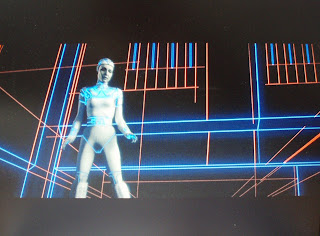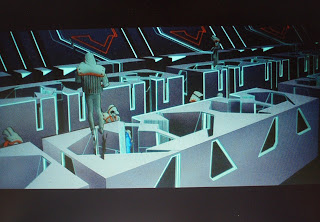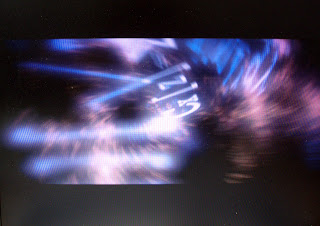Baudrillard’s theory is that in today’s western societies, we live in the “hyperreal” – “the generation by models of a real without origin or reality (1) .” An illustration of the “hyperreal” is a map of an empire drawn so well and to scale that it covers the empire completely. Then when the empire falls, all that’s left is the map (2) . The map itself is just a simulation. But if the simulation (map) is perceived as reality (the intact empire) the simulated reality is considered “hyperreal.”
Baudrillard explains:
“The real is produced from…matrices and memory banks, models of control – and can be reproduced an indefinite amount of times. It no longer needs to be rational…it is no longer anything but operational. It is no longer really the real, because no imaginary envelopes it anymore. It is a hyperreal. (3) ”
Another clear example of the hyperreal in today’s society is Disneyland/Los Angeles. Baudrillard writes: “Disneyland is presented as imaginary in order to make us believe that the rest [of America] is real, whereas all of Los Angeles…[is] no longer real, but belong to the hyperreal order (4) .” His argument is less about the physical entities of Disneyland/Los Angeles (certainly they both exist as real places) but of the attitudes of the people who live in Los Angeles but go to Disneyland for entertainment. “…the adults themselves who come [to Disneyland] act the child in order to foster illusions as to their real childishness (5) .” Childishness is innate in humans, but adulthood – with its etiquette and rigid social expectations, has no basis on any reality of true human nature. Los Angeles is as “fake” a city as Disneyland because the behaviors of the people in Los Angeles have as much basis in reality as the existence of Tinker Bell. Los Angeles is therefore on the order of hyperreal because the behaviors of its inhabitants have no natural origin or any basis in reality.
It was famously noted that Baudrillard felt The Matrix “stemmed mostly from misunderstandings of his work (6) .” “Simulacra and Simulation” is heavily referenced in the film, first as the book in which Neo hides his illegal discs, and with Morpheus’ quote: “Welcome to the desert of the real (7) ” – a line defining the hyperreal taken off the first page of Baudrillard’s text. The screen capture below shows Morpheus and Neo in the Matrix where Morpheus quotes “Simulacra and Simulation.”
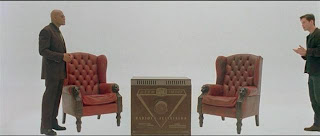
However, the matrix cannot be hyperreal. Certainly it is a simulation – humans are plugged into a machine which mimics the world of 1999. But because 1999 has existed, the simulation therefore has an origin and a reference in a past reality and thus cannot be classified as hyperreal.
A true example of the hyperreal in The Matrix would be the “real” world devastated by the war between humans and machines. A world with such advanced artificial intelligence, a burned earth and sky, and the enslavement of the entire human race can only be imaginary or a fantasy. With no basis in any reality, past, present, or likely future, The Matrix’s “real” world can be classified as hyperreal. In essence, the Wachowski Brothers simply misunderstood which reality in their film is actually hyperreal. If Morpheus had quoted “Simulacra and Simulation” on the deck of the Nebuchadnezzar before Neo’s entrance into the matrix, the interpretation would have been correct. Ignoring this transgression, The Matrix provides a multitude of examples for comparing simulations to reality.
Looking at the matrix simulation in comparison to the “real” world, there obvious visual differences. Christine Cornea explains, “a real/virtual opposition is mapped onto a black/white racial divide…the real world is…African or Afro-Caribbean, while the unreal world is governed by a band of ‘special agents’ who take on white male personas (8) .” Further, the simulated world has undertones of green, while the real world is blue.
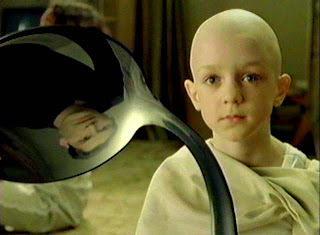
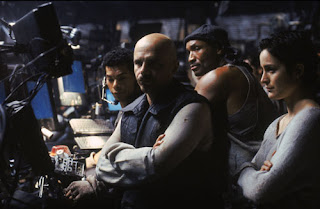
However, some visuals and ideas are associated with both the false and true worlds. Both worlds are completely manufactured. In the matrix, all the settings are urban. In the real world, everything organic has been destroyed and the world is covered in machines. Another motif associated with both the simulation and reality is a dark sky – in the matrix, the sky is always overcast and the sun is never shown, and in the real world, the sky is scorched black.
Tron provides more striking examples of the division between simulation and reality. The real world is presented just like ours in the early 1980s (a simulation of reality, but not a hyperreality). Cyberspace, on the other hand, is purely fantastic. Eric Faden provides an excellent description of Tron’s cyberspace world: “The film’s shadow-less environment features surfaces that absorb, rather than reflect light. […] The film’s look leans more toward avant-garde abstraction…than any ‘realist’ aesthetic. (9)” No place on earth looks like the world in Tron. Further, the movements of the programs inside the computer do not have a basis in reality. For example, in the light cycle game the bikes move in 90-degree angles in an instant.
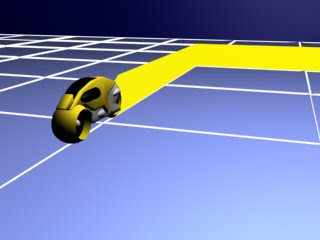
No existing free-moving motor vehicle moves like this. Everything in the cyberspace of Tron is purely fiction, a hyperreal.
There is not much in common between the “real” world in Tron and the fictional cyberspace. Programs carry the appearance of their user’s face and there is a subtle mimicking of real-world behavior in the programs. For instance, the characters Lora and Alan are dating in reality, and their programs, Yuri and Tron, are in love as well.
The simulation in Tron is quite like The Matrix. In both films’ simulations, humans are plugged in and interact within the confines of massive computer programs. All characters are aware of the existence of the simulated world and of the differences between it and reality. Further, characters in both films come to the realization that they can manipulate the false world to a degree, allowing for the final destruction of their enemy. In Tron, the character Flynn realizes that because he’s a user and not a program, he is safe from “being de-resed” allowing him to distract the Master Control Program. In The Matrix, the famed “bullet time” technology shows the extreme speed the characters have while inside the matrix program. In the “real” world of both films, the characters are ordinary. It is within the fantasy of the simulated worlds they become heroes and perform extraordinary feats.
Baudrillard’s unique interpretation of the varying degrees of simulation and reality allow one to view The Matrix and Tron in new ways. Rather than pure fantasy, the films show forms of hyperreality: reality without referent or origin (10) . Further, one can find motifs that appear in both the simulated and real worlds. These subtle similarities help foster the illusion that the simulated world is just as “real” as the real world. The Matrix and Tron provide striking visuals to illustrate Baudrillard’s text.
Notes:
(1) Jean Baudrillard, Simulacra and Simulation, trans. Sheila Faria Glaser (Ann Arbor: The University of Michigan Press, 1994), 1.
(2) Ibid, 1-2.
(3) Ibid, 2.
(4) Ibid, 12.
(5) Ibid, 13.
(6) Richard Hanley, “Simulation and Simulacra: Baudrillard and the Matrix,” What Is the Matrix?, Warner Bros, http://whatisthematrix.warnerbros.com/rl_cmp/new_phil_fr_hanley2.html
(7) The Matrix, dir. Wachowski Brothers, perf. Keanu Reeves, Lawrence Fishbourne, 1999, DVD, Warner Brothers, 1999.
(8) Christine Cornea, Science Fiction Cinema, (New Jersey: Rutgers University Press, 2007), 199.
(9) Eric S. Faden, “Chronophotography and the Digital Image: Whoa…Déjà vu!” 339.
(10) Baudrillard, 1.
Works Cited:
Baudrillard, Jean. Simulacra and Simulation. Translated by Sheila Faria Glaser. Ann
Arbor: The University of Michigan Press, 1994.
Cornea, Christine. Science Fiction Cinema. New Jersey: Rutgers University Press, 2007
Faden, Eric S. “Chronophotography and the Digital Image: Whoa…Déjà vu!”
Hanley, Richard. “Simulation and Simulacra: Baudrillard and the Matrix.” What Is the Matrix? Warner Bros. http://whatisthematrix.warnerbros.com/rl_cmp/new_phil_fr_hanley2.html
The Matrix. Dir. Wachowski Brothers. Perf. Keanu Reeves, Lawrence Fishbourne. 1999.
DVD. Warner Brothers, 1999.
